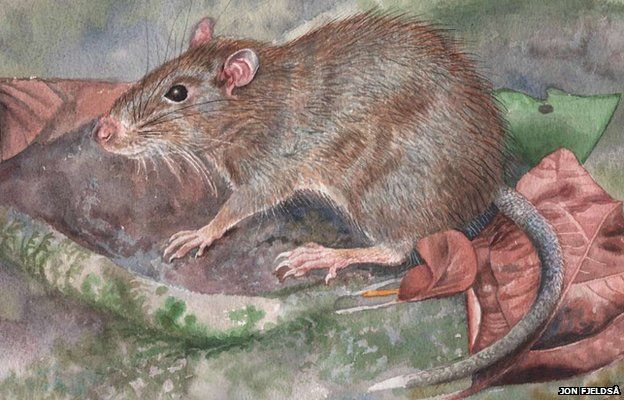New spiny rat discovered in 'birthplace of evolution'
- Published

The rat has unusually coarse, spikey fur on its back and a short tail with a distinctive white tip
Tufts of harsh, bristly hair and a white tail tip are among the defining features of a new rodent species discovered in Indonesia.
The Spiny Boki Mekot Rat was found in the mountain forests of Halmahera, in the Moluccas (Maluku) archipelago.
It was from these islands that Alfred Russel Wallace wrote to Charles Darwin, outlining his theory of evolution.
The region is rich in biodiversity but its wildlife is under threat from logging and mining firms.
Scientists hope the new mammal discovery will encourage greater exploration and conservation of the area.
Their findings are reported in the Zoological Journal of the Linnean Society, external.
Under threat
The new rat was found in a remote, hilly region of Halmahera by an expedition team from the University of Copenhagen and Indonesia's Museum Zoologicum Bogoriense.
They laid traps baited with roasted coconut and peanut butter, placed on tree trunks and at burrow openings.
Among their findings was a previously unknown rodent with coarse, brownish grey fur on its back, and a whitish grey belly.
By analysing the rat's DNA and physical features such as its skull and teeth, they determined it was not only a new species, but an entirely new genus.
They named it Halmaheramys bokimekot after nearby Boki Mekot, a mountainous area under ecological threat due to mining and deforestation.
"This new rodent highlights the large amount of unknown biodiversity in this region and the importance of its conservation," said lead researcher Pierre-Henri Fabre, from the Centre for Macroecology, Evolution and Climate at the University of Copenhagen.
"It's very important that zoologists visit these islands to explore further."
Only six of the new rodents have so far been captured: three adult males and three females.
Little is known about their behaviour, but they are thought to be omnivorous, as the scientists found both vegetable and insect remains in their stomachs.
"This discovery shows how much of the richness of life is left to discover - especially in the Indonesian archipelago," says co-author Kristofer Helgen, of the Smithsonian Institution, Washington DC, US.
Prof Helgen was among the team that recently discovered a giant rat, external living in a volcano crater in Papua New Guinea, as well as a new mammal carnivore in Colombia - the Olinguito.
"There are likely to be more undiscovered species of mammals in Indonesia than in any other country in the world," he says.
"Finding and documenting them is a task made urgent by huge environmental threats, especially logging and mining."
Birthplace of evolution
The new rodent also provides clues to how mammals evolved and spread across the "stepping stones" of the Moluccas - known as one of the birthplaces of evolutionary theory.
It was here in 1858 that the British naturalist Sir Alfred Russel Wallace famously wrote to Charles Darwin, outlining his ideas on the development of new species.
The correspondence led to their eventual co-publishing of a theory of natural selection.
The rat could be just one of many undiscovered mammal species in Indonesia's remote mountain forests
Wallace had been struck by the incredible diversity of animals and insects in the Moluccas - a transition zone between Asia and Australasia.
He also observed a clear border between species in western and eastern Indonesia, leading him to define a zoological boundary - the Wallace Line.
And the discovery of this new rodent on Halmahera actually supports Wallace's original drawing of the boundary, the researchers say.
Most fauna on the island display eastern, Australasian characteristics. But H. bokimekot is different - its DNA indicates that it first arrived on Halmahera from the west - from Asia.
"It's amazing that the spiny rat once again confirms Wallace's thoughts," says Dr Lionel Hautier, at the Museum of Zoology, University of Cambridge, UK.
"And as chance would have it, the discovery comes exactly 100 years after his death."
- Published15 August 2013
- Published26 June 2013
- Published19 June 2013
- Published27 September 2012